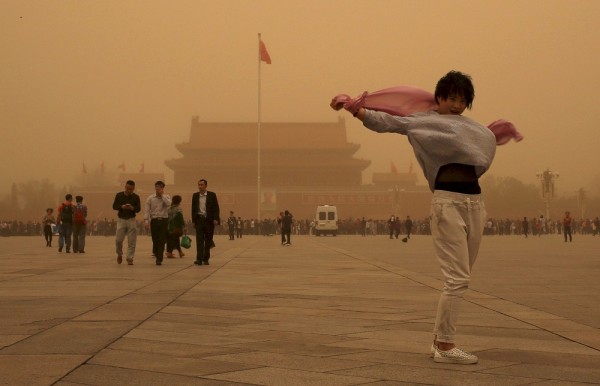Sandstorm Hits Beijing, Strongest In 13 Years
| Vittorio Hernandez | | Apr 17, 2015 01:02 AM EDT |
(Photo : Reuters) A tourist gestures as she poses for a photograph at Tiananmen Square during a sandstorm in Beijing, April 15, 2015.
Beijing's air pollution is bad enough, but to worsen things further for residents and workers in China's capital city, a sandstorm hit the city on Wednesday evening.
It was the strongest sandstorm to hit the city in 13 years, reports the Legal Mirror, that employees and residents rushed home for fear that they would be caught in Beijing's notorious gridlock. They made the mad rush after the national observatory issued a sandstorm yellow alert.
Like Us on Facebook
A yellow alert is the third-most serious, meaning visibility would plummet below 1,000 meters. As a result of the sandstorm, coupled with Beijing's perennial air pollution problem, many areas in the city logged PM10 air pollution readings of almost 1,000 micrograms per cubic meter, considered a hazardous level.
Likewise, the U.S. embassy recorded readings of PM2.5 particulates over 300, also a hazardous level. The PM2.5 particulates are the most dangerous to human health.
The sandstorm dust went beyond Beijing and affected also parts of Xinjiang, Inner Mongolia, Ningxia, Tianjin, Gansu, Shaanxi, Shanxi, Hebei and Jilin, according to the National Meteorological Service. This caused power outages and traffic in China's northwest region when the strong winds blew the dust and sand across the Xinjiang Uyghur Autonomous Region as visibility dropped to less than 10 meters.
Among the comments by Beijing residents was that it was dirty that one felt it was the end of the world. Another felt like they were residing in a desert. Many travelers had to wear face masks as protection against the dust.
The sandy weather turned the Beijing skyline to orange in the afternoon.
Authorities advised residents to stay indoors. Those who still went out and took photos found that the images showed smudged outlines of edifices and people, reports Shanghaiist.
In 2013, a similar sandstorm blanketed Beijing. City officials then blamed the sandstorm to Inner Mongolia where the weather disturbance came from.
Besides the sandstorm, China's National Meteorological Center forecast that a strong cold front would hit northern China, causing temperatures to drop to 12 degrees Celsius in some areas, particularly along the Yellow and Huaihe Rivers.
©2015 Chinatopix All rights reserved. Do not reproduce without permission
EDITOR'S PICKS
-

Did the Trump administration just announce plans for a trade war with ‘hostile’ China and Russia?
-

US Senate passes Taiwan travel bill slammed by China
-

As Yan Sihong’s family grieves, here are other Chinese students who went missing abroad. Some have never been found
-

Beijing blasts Western critics who ‘smear China’ with the term sharp power
-

China Envoy Seeks to Defuse Tensions With U.S. as a Trade War Brews
-

Singapore's Deputy PM Provides Bitcoin Vote of Confidence Amid China's Blanket Bans
-

China warns investors over risks in overseas virtual currency trading
-

Chinese government most trustworthy: survey
-

Kashima Antlers On Course For Back-To-Back Titles
MOST POPULAR
LATEST NEWS
Zhou Yongkang: China's Former Security Chief Sentenced to Life in Prison

China's former Chief of the Ministry of Public Security, Zhou Yongkang, has been given a life sentence after he was found guilty of abusing his office, bribery and deliberately ... Full Article
TRENDING STORY

China Pork Prices Expected to Stabilize As The Supplies Recover

Elephone P9000 Smartphone is now on Sale on Amazon India

There's a Big Chance Cliffhangers Won't Still Be Resolved When Grey's Anatomy Season 13 Returns

Supreme Court Ruled on Samsung vs Apple Dispute for Patent Infringement

Microsoft Surface Pro 5 Rumors and Release Date: What is the Latest?












